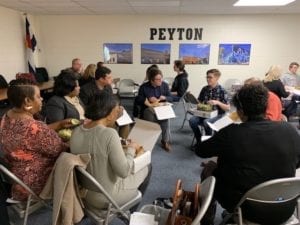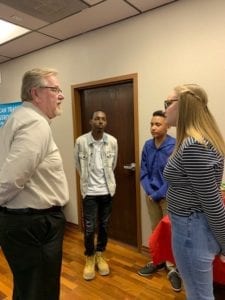
Dr. Loretta Goodwin,
AYPF Deputy Director
This post was originally published in April, 2019. To celebrate the value of CTE and the achievements and accomplishments of CTE programs across the country during CTE month, we wanted to highlight the work Colorado is doing in promoting CTE in rural areas. In March of last year, AYPF organized a study tour to hear directly from schools and state and district education policy leaders on policy conditions that support the promotion of deeper learning and CTE in Colorado. This post aims to expand the knowledge of how the integration of deeper learning and CTE is being accomplished and scaled in rural areas.
How can state leaders improve the alignment between education, business, and the workforce as they prepare students for the future? This is a challenging quest, especially in rural areas, highlighting as it does the issue of providing all students with equitable educational opportunities. I was heartened by our grappling with these issues on a recent AYPF study tour to Colorado Springs, Colorado. Through discussions with state, district, and school leaders, site visits to the Career Technical Education Facility in the Peyton School District and the Manufacturing Industry Learning Lab in the Widefield School District, and conversations with students and teachers, we learned about policies that are preparing students with the content knowledge and 21st century skills necessary for postsecondary success.
As the conversation commenced, trip participants from Michigan, New Jersey, Mississippi, and the Department of Defense Education Activity shared the challenges they face in aligning education and workforce needs:
- Rural locations make providing students with rich hands-on learning opportunities difficult, due to limited business and industry partners available who can provide internships and work-based learning;
- High schools are often separated from career centers, necessitating long travel time;
- Integrating industry credentials and competencies into the high school curriculum can prove challenging;
- Teacher shortages abound in rural locations, as the isolated nature of these settings make it difficult to attract and retain teachers;
- Legislative backing and sufficient funding is necessary to prioritize the integration of education and career services, but this support is sometimes difficult to muster.
 Supportive Policies
Supportive Policies
Colorado has been actively combatting these challenges, and we learned from the policies their state leaders shared as well as from the contributions of visiting states. Recognizing that most jobs will require an education beyond high school, Colorado has been strengthening the education-to-workforce pipeline, at the same time emphasizing that students hone what is known as the deeper learning competencies: content mastery; critical thinking and problem solving skills; collaboration; communication; and a self-directed growth mindset. The Colorado Department of Education’s 2017-2022 Strategic Plan emphasizes that “Students will earn a postsecondary credential, degree or certificate in or after high school.” As Elliott Asp, of the Colorado Education Initiative, reminded us, much of this focus on student success is driven by the ‘Colorado Paradox’, where the state has many highly educated citizens, but most do not come from Colorado schools.
 Throughout our trip we heard about how much CO is a local control state. As such, the state role is to provide guidance and guidelines, an example being the current draft Graduation Guidelines that offer districts a menu of options that students must use to show what they know in order to graduate. These include concurrent enrollment, district capstones, industry certificates, and collaboratively developed standards-based performance assessments. As the draft notes, “local school boards establish high school graduation requirements that meet or exceed the Colorado Graduation Guidelines for the graduating class of 2021.” These graduation guidelines demonstrate the state’s expectation that students graduate from high school prepared to be successful in school and in life, earning a living wage and contributing to Colorado’s economy, as well as the state’s commitment to educating students so they enter the workforce with in-demand skills that meet business, industry, and higher education standards. Elliot noted that many districts are using the draft guidelines, including performance-based options, as a way for students to demonstrate mastery.
Throughout our trip we heard about how much CO is a local control state. As such, the state role is to provide guidance and guidelines, an example being the current draft Graduation Guidelines that offer districts a menu of options that students must use to show what they know in order to graduate. These include concurrent enrollment, district capstones, industry certificates, and collaboratively developed standards-based performance assessments. As the draft notes, “local school boards establish high school graduation requirements that meet or exceed the Colorado Graduation Guidelines for the graduating class of 2021.” These graduation guidelines demonstrate the state’s expectation that students graduate from high school prepared to be successful in school and in life, earning a living wage and contributing to Colorado’s economy, as well as the state’s commitment to educating students so they enter the workforce with in-demand skills that meet business, industry, and higher education standards. Elliot noted that many districts are using the draft guidelines, including performance-based options, as a way for students to demonstrate mastery.
A critical step in aligning education and business was the 2010 reconstitution of the Colorado Workforce Development Council (CWDC), whose focus is on business, improving the quality of the workforce, and encouraging career mobility. This Council is governor-appointed and brings together partners from across the talent development network — including workforce development, economic development, and education and training — focused on ensuring student and job seekers have access to meaningful career pathways and businesses have access to the talent they need. The Council convenes industry leaders and educators and together they have identified the skills needed for key jobs.  The creation of the Commissioner’s Rural Education Council is another critical piece of the puzzle, as the council’s quarterly meetings include superintendents, principals, and teachers, all of whom have an opportunity to inform the Commissioner, currently Katy Anthes, about the challenges they are facing, including how rules may impact rural districts. Denille LePlatt, Director of Rural Services, CO Department of Education, shared that, to counteract rural capacity issues and access to services, many districts are collaborating to provide options to students. We certainly saw this in action with the collaboration between Peyton and Widefield school districts. Working together under the guidance of Superintendents Scott Campbell (Widefield) and Tim Kistler (Peyton), the Manufacturing Industry Learning Lab (MiLL) was created to train students for industry-level jobs. Particularly impressive is the MiLL’s host of industry partners, as well as their use of local volunteers to assist students.
The creation of the Commissioner’s Rural Education Council is another critical piece of the puzzle, as the council’s quarterly meetings include superintendents, principals, and teachers, all of whom have an opportunity to inform the Commissioner, currently Katy Anthes, about the challenges they are facing, including how rules may impact rural districts. Denille LePlatt, Director of Rural Services, CO Department of Education, shared that, to counteract rural capacity issues and access to services, many districts are collaborating to provide options to students. We certainly saw this in action with the collaboration between Peyton and Widefield school districts. Working together under the guidance of Superintendents Scott Campbell (Widefield) and Tim Kistler (Peyton), the Manufacturing Industry Learning Lab (MiLL) was created to train students for industry-level jobs. Particularly impressive is the MiLL’s host of industry partners, as well as their use of local volunteers to assist students.
Another important focus has been on the creation of student-centered career pathways, offered under industry sectors such as engineering, health, business, culinary arts, etc. Policy initiatives included creating a career pathway for students interested in the manufacturing industries in 2013 (HB 13-1165). In 2015, HB 15-1274 specified the development of career pathways for critical occupations in growing industries including construction and related skilled trades, information technology (IT), and health care. 
It was encouraging to hear from school leaders in Peyton and Widefield about the direct impact the Career Success Pilot Program, which launched in 2016, has had on their ability to provide students with a range of options beyond high school. This pilot, which has since been extended and received increased funding, provides financial incentives to districts and charter schools for each high school student who successfully completes any of the following: qualified industry credential programs, internships, residencies, construction pre-apprenticeships or construction apprenticeship programs, or qualified Advanced Placement (AP) courses. The program has increased industry credential attainment in high school, with numbers rising from a few hundred to thousands over the past three years. To date, over 37 school districts have participated (13 of them are classified as rural districts), and over 5,600 credentials/courses have been reported.
One way students can gain work experience is through apprenticeship and pre-apprenticeship programs, yet it is difficult for states to expand these options, which can address equity by offering career pathways for underrepresented populations. In Colorado in 2016, HB 16-1287 was designed to study, understand, and address the barriers to expanding these programs. The recommendations from the resulting report were included in Colorado’s 2018 Talent Pipeline Report. Through various funding sources, such as the ApprenticeshipUSA State Expansion Grant, Colorado secured more than $2.5 million to support work to increase the number and diversity of registered apprenticeship programs across the state. Another state-led initiative to increase apprenticeship options is CareerWise Colorado.  Ryan Gensler (Director of National Partnerships, CareerWise) noted that the goal of the program is to have one in ten high school students in an apprenticeship program by 2027. In a follow-up presentation Ryan conducted for Michigan (spurred by participants on our tour, and MI’s concern about their talent shortage, especially in manufacturing), State Senator McBroom and other community Upper Peninsula leaders learned about Colorado’s approach to apprenticeships.
Ryan Gensler (Director of National Partnerships, CareerWise) noted that the goal of the program is to have one in ten high school students in an apprenticeship program by 2027. In a follow-up presentation Ryan conducted for Michigan (spurred by participants on our tour, and MI’s concern about their talent shortage, especially in manufacturing), State Senator McBroom and other community Upper Peninsula leaders learned about Colorado’s approach to apprenticeships.
Above are just some of the promising policies that were highlighted, and the conversation was by no means confined to just learning what Colorado was doing, but also what our visiting states were engaged in. Michigan’s participants, for example, informed us about their Early Middle College model. New Jersey participants described their efforts to encourage women and minorities to enter traditionally-male-dominated occupations, through targeted outreach to these groups by NJ’s Department of Labor.
States recognize that they have to prioritize educating ALL their citizens to be able to lead productive lives and to contribute to a healthy economy. The work is challenging, but this study tour certainly made me hopeful that progress is being made, especially for rural populations.


